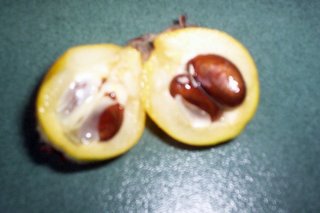Luscious Loquats
 Robert cuts down bunches of loquats from the tree every few days while they are ripening. The ones at the top are left for the birds...crimson rosellas, yellow winged honey eaters, blackbirds and wattle birds mostly. A bucketful will make about 5x250 ml jars of jelly.
Robert cuts down bunches of loquats from the tree every few days while they are ripening. The ones at the top are left for the birds...crimson rosellas, yellow winged honey eaters, blackbirds and wattle birds mostly. A bucketful will make about 5x250 ml jars of jelly.The larger yellow loquats are about three cm long. I try to use a mixture of ripe and half ripe ones so that the jelly sets well. The fruits can be eaten raw when they are yellow but are small and fiddly. That's also
 why I make jelly and not jam. For jam I would have to peel the darned things.
why I make jelly and not jam. For jam I would have to peel the darned things. 
Inside are some large brown pips which we push out with our thumbs and because the flesh goes brown quickly they get put straight into a saucepan of water. When they are all done I make sure that the water just covers them and then I put it all on to cook for about half an hour , till they are mushy.
I
 strain them through this amazing gadget that I bought on ebay a couple of years ago.
strain them through this amazing gadget that I bought on ebay a couple of years ago.I line it with a clean cloth and leave the juice and pulp to drip through it overnight.
The juice is saved and the pulp is chucked into the compost.
This gadget was made in America and is part of my growing collection of Kitchenalia. It's lovely to have something collectable and usable too. I use it for the crab apple jelly as well.
For every cup of juice I add a cup of white sugar, and to the 5 or 6 cups of juice that I get from each bucket of loquats, I add the juice of two lemons, a tablespoon of rosewater and 2 drops of cochineal. Any more cochineal would make it look luridly coloured. The two drops is just enough to give it a blush.

I boil it all till it reaches setting point. I test this with a thermometer and when it gets to 104 degrees C I start to chill bits on a saucer in the fridge. If you push your finger through a cold sample it should wrinkle up as if a skin is forming on top. This means it should jell if bottled and left well alone till it is cold.
It is too sweet for my own taste but it's delightfully delicate and perfumed and so very pretty.
Please can reader/s let me know what they think it might be best used for. Putting it on breakfast toast is an obvious one but I think it deserves more and I would love to be able to make some daring suggestions to the people who come to my jam stall and show an interest in it.
More on cardis next post!
Cheers Gillian


6 Comments:
What lovely jelly. It sounds like it would go well with meat or in cookies.
By Becky, At
8:31 PM
Becky, At
8:31 PM
Might be a nice alternative to quince jelly (with camembert cheese) or cranberry (turkey or pork?). Send me some and I'll let you know ;) looks nice!
By Deleted, At
9:20 PM
Deleted, At
9:20 PM
A glaze of some sort for pork, perhaps? Or maybe even duck. Cut with an astringent herb (rosemary?) it could be the base of a yummy sauce.
By Taphophile, At
5:32 AM
Taphophile, At
5:32 AM
Ooh that jelly looks so nice, and the color is quite pretty. It sounds as though you have been having a lovely time making it too.
By Sue, At
12:06 AM
Sue, At
12:06 AM
I was thinking it would be good on a cheese platter as a replacement for quince jelly too. And I love the idea of glace for duck... yum yum...
By Ginger_nut, At
3:04 PM
Ginger_nut, At
3:04 PM
loquat jelly ..nice on toast..hot buttery toast ..mmmmmmmm.
by the way.. what a great strainer ...If I make jelly I have to rig up a cheesecloth device between two chairs ..Yours is so good ...looks like the person who made it knew what they were doing .
By melissa, At
2:59 PM
melissa, At
2:59 PM
Post a Comment
Subscribe to Post Comments [Atom]
<< Home